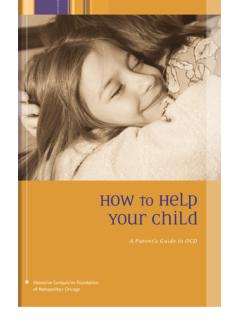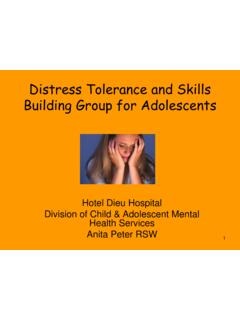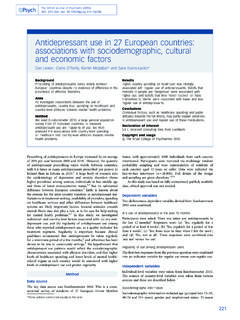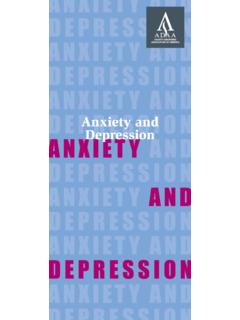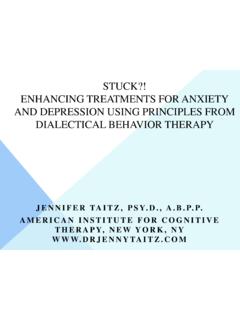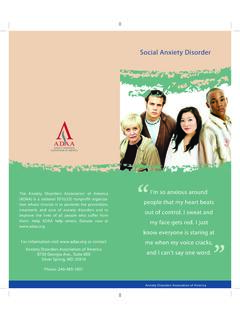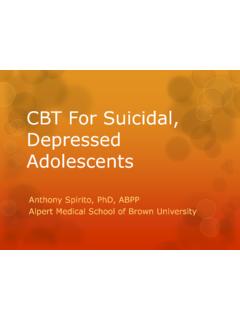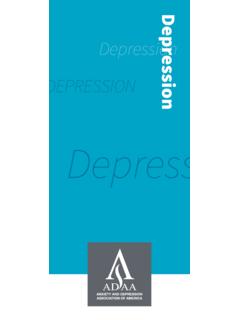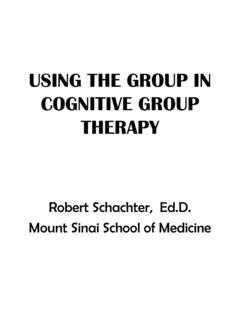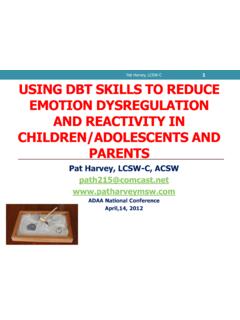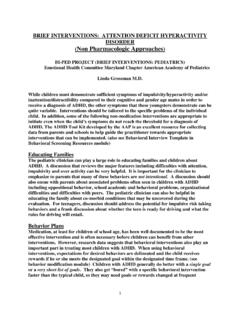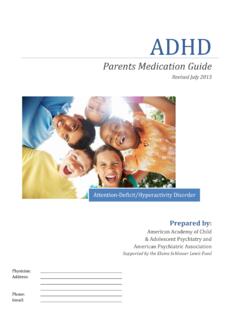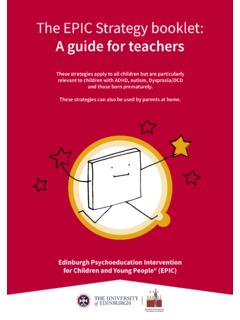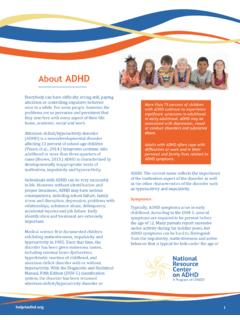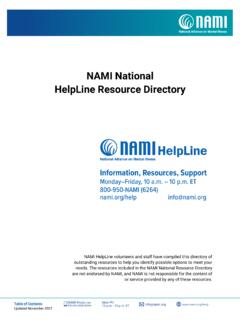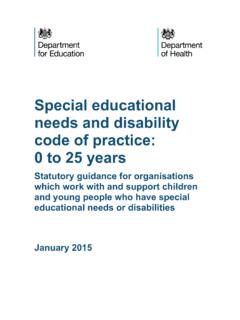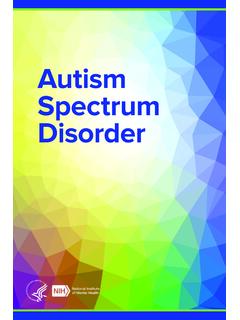Transcription of Anxiety Disorders in Children - Anxiety and Depression ...
1 Anxiety Disorders nchildren anx ety Disorders nchildrenanx ety Disorders nchildrenanx ety childrenAnxiety Disorders in ChildrenAnxiety Disorders are common, treatable medical conditions that affect one in eight Children . They are characterized by persistent, irrational, and overwhelming worry, fear, and Anxiety that interfere with daily activities. These are real Disorders that affect how the brain functions. Symptoms vary but they can include irritability, sleeplessness, jitteriness or physical symptoms such as headaches and stomachaches. An Anxiety disorder can prevent your child from making friends, raising a hand in class, or participating in school or social activities.
2 Feelings of being ashamed, afraid, and alone are not has shown that if left untreated, Children with Anxiety Disorders are at higher risk to perform poorly in school, miss out on important social experiences, and engage in substance abuse. Anxiety Disorders also often co-occur with other Disorders such as Depression , eating Disorders , and attention-deficit/hyperactivity disorder (ADHD).Whether your child has been diagnosed with an Anxiety disorder or you are concerned about your child s anxious behavior, the Anxiety Disorders Association of America (ADAA) is here to help. In this booklet you will learn about Anxiety disorder symptoms, treatments that work, and how to find a qualified mental health provider.
3 With treatment and your support, your child can learn how to successfully manage the symptoms of an Anxiety disorder and live a normal this just a phase? Anxiety vs. an Anxiety disorderAnxiety is a normal part of childhood, and every child goes through phases. Some may eat only orange foods or count in twos. Others may have an imaginary friend or have recurring nightmares about monsters under the bed. The difference between a phase and an Anxiety disorder is that a phase is temporary and usually harmless. Children who suffer from an Anxiety disorder experience fear, nervousness, shyness, and avoidance of places and activities that persist despite the helpful efforts of parents , caretakers, and Disorders tend to become chronic and interfere with how your child functions at home or at school to the point that your child becomes distressed and uncomfortable and starts avoiding activities or people.
4 Unlike a temporary phase of fear, such as seeing a scary movie and then having trouble falling asleep, reassurance and comfort is not enough to help a child with an Anxiety disorder get past his or her fear and an Anxiety screening at Then talk to your doctor, who can help you figure out what s normal behavior for your child s age and development level. Your doctor can refer you to a mental health professional, if necessary, for a more complete evaluation. What causes Anxiety Disorders ?Experts believe Anxiety Disorders are caused by a combination of biological and environmental factors, similar to allergies and diabetes. Stressful events such as starting school, moving, or the loss of a parent or grandparent can trigger the onset of an Anxiety disorder, but stress itself does not cause an Anxiety disorder.
5 Anxiety Disorders tend to run in families, but not everyone who has one passes it on to their Children . Neither you nor your child is at fault, and an Anxiety disorder diagnosis is not a sign of weakness or poor and related Disorders in Children The term Anxiety disorder refers to a group of mental illnesses that includes generalized Anxiety disorder (GAD), obsessive-compulsive disorder (OCD), panic disorder, posttraumatic stress disorder (PTSD), social Anxiety disorder (also called social phobia), and specific phobias. Each Anxiety disorder has specific Anxiety dIsorder (GAd)If your child has generalized Anxiety disorder, or GAD, he or she will worry excessively about a variety of things, which may include but are not limited to these issues:Family problems Relationships with peers Natural disasters Health Grades Performance in sports Punctuality Typical physical symptoms:Fatigue or an inability to sleep Restlessness Difficulty concentrating Irritability Children with GAD tend to be very hard on themselves and they strive for perfection.
6 These Children may also seek constant approval or reassurance from others, even when they appear not to have any worries. 45obsessIve-compulsIve dIsorder (ocd)OCD is characterized by unwanted and intrusive thoughts (obsessions) and feeling compelled to repeatedly perform rituals and routines (compulsions) to try to ease , irrational worry about dirt, germs, or contaminationExcessive concern with order, arrangement, or symmetryFear of harm or danger to a loved one or self Religious rules or rituals Intrusive words or sounds Fear of losing something valuable COmpulsiOnsWashing and rewashing hands to avoid exposure to germs Arranging or ordering objects in a very specific way Checking and re-checking objects, information, or situations Repeating a name, phrase, tune, activity.
7 Or prayer Hoarding or saving useless items Counting objects such as steps Seeking reassurance or doing things until they seem just rightMost Children with OCD are diagnosed around age 10, although the disorder can strike Children as young as two or three. Boys are more likely to develop OCD before puberty, while girls tend to develop it during adolescence. Research has shown that for teens with the eating disorder anorexia nervosa, OCD is the most common co-existing more about OCD at The first thing we did to help make my OCD go away was get a diagnosis from a psychiatrist. I also spent two hours every Friday doing exposure and response prevention therapy.
8 Therapy has really helped my OCD. My OCD is not in control of my life, and I am much happier. Lo r i, a g e 12pAnIc dIsorderPanic disorder is diagnosed if your child suffers at least two unexpected panic or Anxiety attacks which means they come on suddenly and for no reason followed by at least one month of concern over having another attack, losing control, or going crazy. A panic attack includes at least four of the following symptoms:Feeling of imminent danger or doom The need to escape Rapid heartbeat Sweating Trembling Shortness of breath or a smothering feeling Feeling of choking Chest pain or discomfort Nausea or abdominal discomfort Dizziness or lightheadedness Sense of things being unreal, depersonalization Fear of losing control or going crazy Fear of dying Tingling sensations Chills or hot flushes Agoraphobia can develop when Children begin to avoid situations and places in which they had a previous panic attack or fear they would be unable to escape if experiencing an attack.
9 Refusing to go to school is the most common manifestation of agoraphobia in kids. 67posttrAumAtIc stress dIsorder (ptsd) Children with posttraumatic stress disorder, or PTSD, may have intense fear and Anxiety ; become emotionally numb or easily irritable; or avoid places, people, or activities after experiencing or witnessing a traumatic or life-threatening event. These events can include a serious accident, violent assault, physical abuse, or a natural disaster. Children with PTSD often re-experience the trauma of the event through nightmares or flashbacks, or re-create them through play. They can have difficulty sleeping or concentrating. Other symptoms include nervousness about one s surroundings, acting jumpy around loud noises, and withdrawing from friends and family.
10 Symptoms may not appear until several months or even years after the event. Not every child who experiences or witnesses a traumatic event will develop PTSD. It is normal to be fearful, sad, or apprehensive after such events, and many Children will recover from these feelings in a short most at risk for PTSD are those who directly witnessed a traumatic event, who suffered directly (such as injury or the death of a parent), had mental health problems before the event, and who lack a strong support network. Violence at home also increases a child s risk of developing PTSD after a traumatic Anxiety dIsorderMany Children experience separation Anxiety between 18 months and three years old, when it is normal to feel some Anxiety when a parent leaves the room or goes out of sight.
